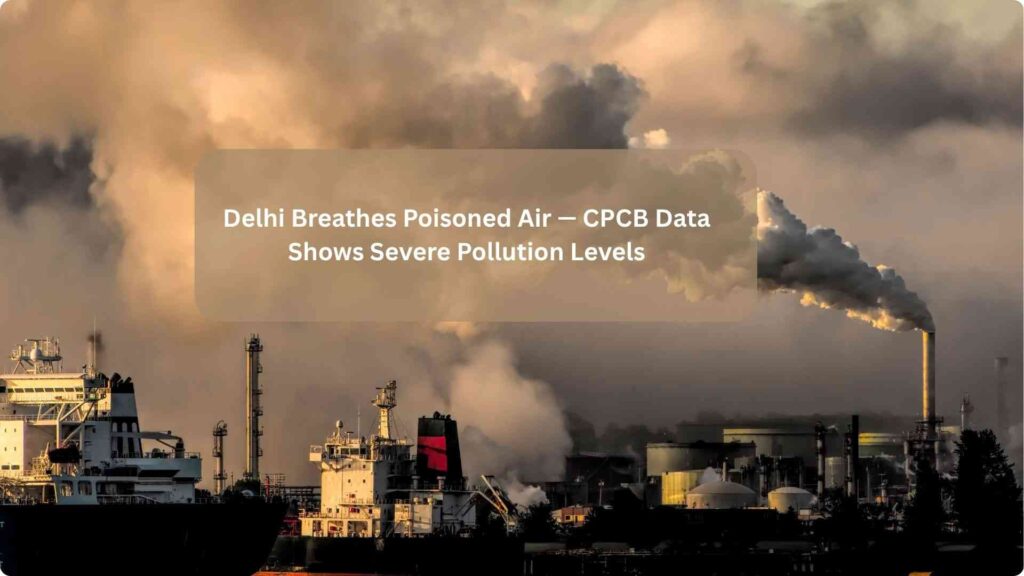Delhi’s Air Quality Remains ‘Very Poor’ for Fourth Straight Day — AQI Soars Across Key Areas

New Delhi, October 23, 2025: The air quality in the national capital has continued to deteriorate, slipping deeper into the ‘Very Poor’ category for the fourth consecutive day, as per data released by the Central Pollution Control Board (CPCB). Early morning readings at 6 a.m. showed Delhi recording an overall Air Quality Index (AQI) of 332, signaling worsening pollution levels across most monitoring stations.
Just a few days after a firecracker-filled Diwali, the city finds itself once again wrapped in a thick blanket of smog and haze, with visibility dropping and health concerns on the rise.
Delhi’s Area-Wise AQI: Anand Vihar Tops the Chart Again
According to the CPCB’s real-time monitoring data, several regions in Delhi have recorded hazardous air quality levels. Some areas even crossed into the ‘Severe’ category, indicating extremely unhealthy air that can impact even healthy individuals.
| Area | AQI | Category |
|---|---|---|
| Anand Vihar | 429 | Severe |
| Jahangirpuri | 367 | Very Poor |
| Wazirpur | 365 | Very Poor |
| ITO | 353 | Very Poor |
| Ashok Vihar | 350 | Very Poor |
| Burari | 348 | Very Poor |
| Punjabi Bagh | 344 | Very Poor |
| Sonia Vihar | 329 | Severe |
| Shadipur | 319 | Very Poor |
| Alipur | 300 | Poor |
Meanwhile, NCR regions are not far behind. In Gurugram’s Sector 51, the AQI stood at 288 (‘Poor’), while Noida’s Sector 125 registered 308 (‘Very Poor’). Ghaziabad’s Indirapuram also recorded 271, reflecting poor air quality conditions spreading across the entire Delhi-NCR belt.
Smog Blankets Delhi: Winds Too Weak to Disperse Pollutants
A thick cloud of smog enveloped Delhi through the day on Wednesday, reducing visibility and adding a noticeable haze to the skyline. According to the India Meteorological Department (IMD), the situation is unlikely to improve soon due to stagnant wind patterns and low wind speeds.
“Wind speeds are currently between 5 to 7 kmph during the day, while nights are almost calm. These calm conditions prevent pollutants from dispersing,” said Krishna Mishra, Senior Scientist at IMD.
He added that although wind direction has now shifted from easterly to westerly, the overall conditions remain unfavorable for pollution clearance. A weak western disturbance is expected to approach around October 27, but IMD has clarified that it is unlikely to bring rain or significant improvement in wind speed.
A Temporary Relief That Didn’t Last Long
Earlier this week, a brief surge in wind speed helped clear out the smoke and emissions left behind by Diwali festivities. However, by Tuesday night, winds dropped once again, coinciding with a fall in temperature, leading to the reaccumulation of pollutants near the surface.
Experts say that as temperatures continue to dip and wind flow remains sluggish, particulate matter (PM2.5 and PM10) will keep accumulating in the atmosphere, pushing air quality back to “very poor” levels.
CPCB and EWS Forecast: No Major Improvement Till Weekend
Forecasts from the Centre’s Air Quality Early Warning System (EWS) suggest that Delhi’s air quality will continue to stay in the ‘Very Poor’ range until at least Saturday. Beyond that, the AQI may fluctuate between ‘Poor’ and ‘Very Poor’ for nearly a week, depending on minor weather changes.
Environmental scientists have stressed that localized emissions, including construction dust, vehicular exhaust, and stubble burning, are major contributors at this stage. With meteorological conditions unfavorable for dispersion, these pollutants are trapped within the city’s boundary layer.
Health Advisory for Residents
Health experts have urged residents—especially children, elderly citizens, and those with respiratory issues—to limit outdoor exposure and use N95 masks when stepping out. People are also advised to avoid morning walks in open areas and keep air purifiers running indoors.
Common symptoms like coughing, throat irritation, and watery eyes are likely to intensify during this period, while long-term exposure may worsen conditions like asthma, bronchitis, and heart disease.
Authorities on Alert, Measures Intensified
Authorities in Delhi and NCR have intensified pollution control measures under the Graded Response Action Plan (GRAP). Construction activities at non-essential sites have been temporarily restricted, and mechanized road cleaning and water sprinkling are being ramped up across the city.
Despite these steps, experts emphasize that unless weather conditions improve, short-term measures may offer only marginal relief.
What Lies Ahead
With the festive season behind and winter setting in, Delhi’s annual “pollution season” appears to be in full swing. The combination of calm winds, temperature inversion, and regional crop residue burning is likely to keep pollution levels elevated for days to come.
Unless there’s a sudden spell of rain or strong winds, the capital may continue to breathe toxic air—making it one of the world’s most polluted major cities yet again.